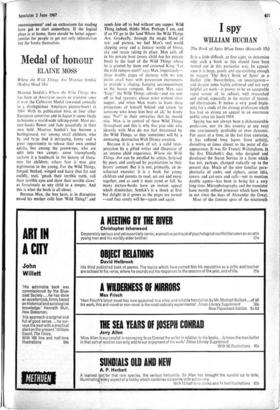Medal of honour
ELAINE MOSS
Where the Wild Things Are Maurice Sendak (Bodley Head I8s) Maurice Sendak's Where the Wild Things Are has been an American succis de scandale since it won the Caldecou Medal (awarded annually to a distinguished American picture-book) in 1964 With its publication here, in four other European countries and in Japan it seems likely to become a world-wide talking-point. Most pic- ture-books flower and fade peacefully in their own field. Maurice Sendak's has become a battleground, not among small children, who by and large .find it intriguing, funny and a great opportunity to release their own animal spirits, but .among the grown-ups, who are split into twa camps: some triumphantly acclaim it a landmark in the history of litera- ture for children; others fear it may give nightmares to the young. For the Wild Things, fanged, beaked, winged and hairy (but fat and cuddly, too), 'gnash their terrible teeth, roll their terrible eyes and show their terrible claws' as ferociously as any child in a temper. And this is what the book is all about.
Because Max, the boy hero, is in disruptive mood his mother calls him 'Wild Thine and
sends him off to bed without any supper. Wild Thing indeed, thinks Max. Perhaps I am, and if so I'll go to the land Where the Wild Things Are. Gradually, through the magic blend of text and picture, we feel Max's real world slipping away and a fantasy world of forest, sky and ocean taking its place. Max sails off in his private boat (every child has his private boat) to the land of the Wild Things where he is greeted by them and crowned King. 'Let the wild rumpus start!' says Max, imperiously— three double pages of pictures with no text invite small boys with percussion instruments to provide a ringing, banging accompaniment to the beasts rampant. But when Max says 'Stop!' the Wild Things subside—and are sent off to bed (parents, please note) without their supper; and when Max wants to leave these projections of himself behind and return 'to someone who loves him best of all,' he firmly says 'No!' to their entreaties that he should stay. Max is in control of these Wild Things throughout and this is why five year olds who identify with Max do not feel threatened by the Wild Things, as they 'sometimes will by a menacing, destructive Walt Disney creation.
Because it is a work of art, a valid inter- pretation by a gifted writer and illustrator of an intense child experience, Where the Wild Things Are can be extolled by artists, lyricised by poets and analysed by psychiatrists to their hearts' content. But it is not, primarily, an in- tellectual exercise; it is a book for young children and parents to read, act out and enjoy together, and as such it must stand or fall. So many picture books have an instant appeal which diminishes; Sendak's is a shock at first but delight in it grows as the pages are turned —and they surely will be—again and again.


































 Previous page
Previous page